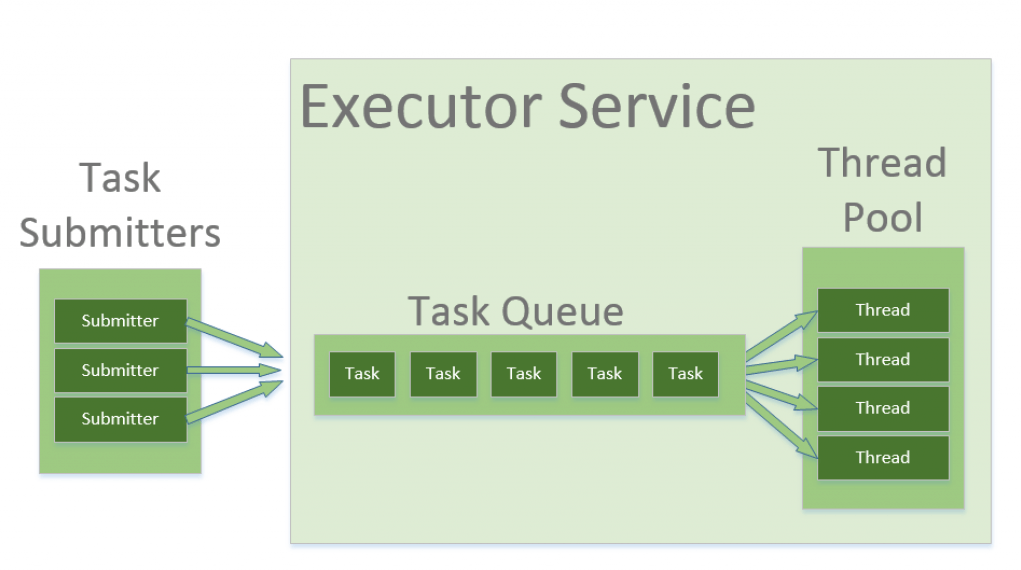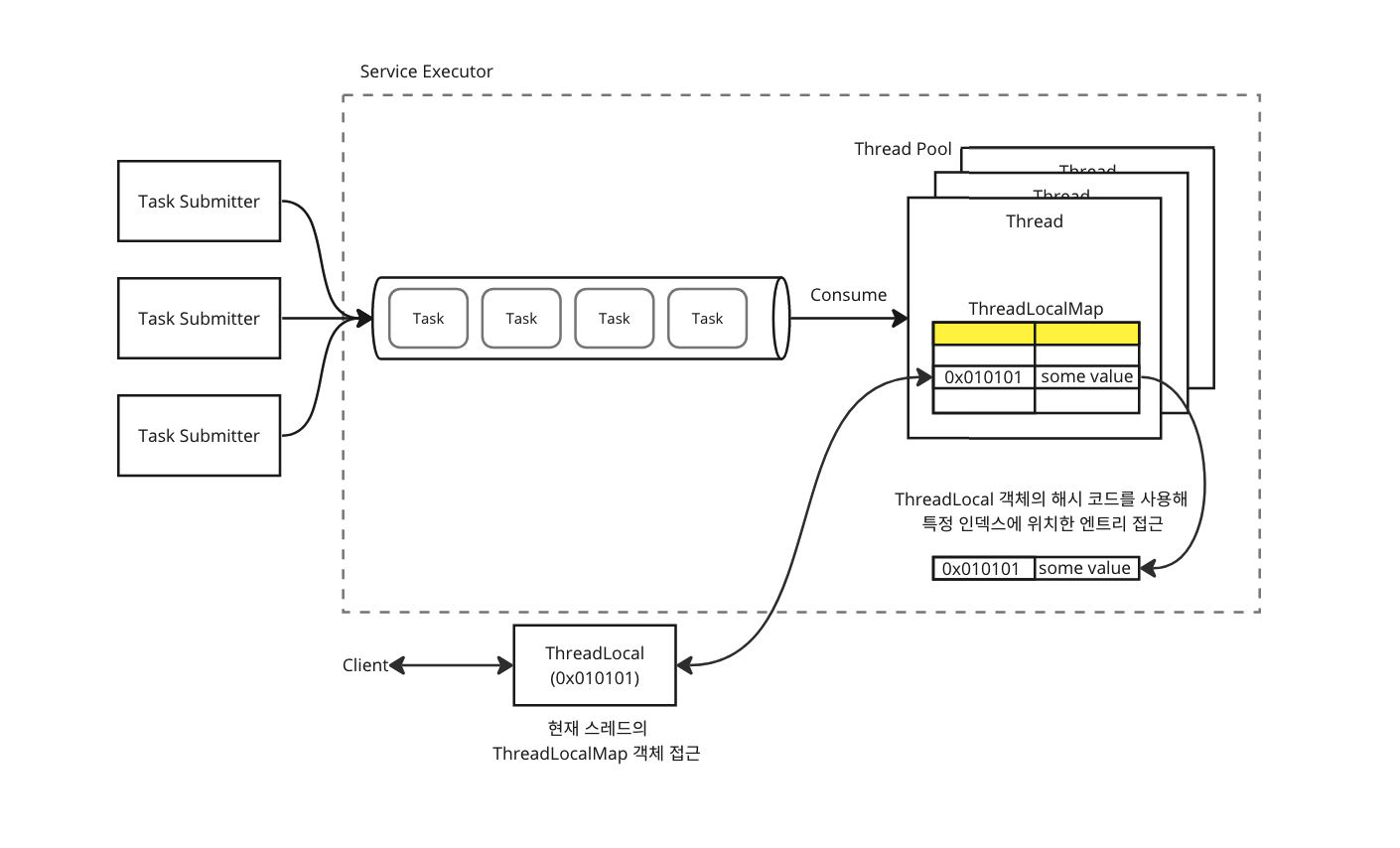ThreadLocal 클래스 사용 시 주의점
RECOMMEND POSTS BEFORE THIS
0. 들어가면서
ThreadLocal Class 글에서 ThreadLocal 클래스에 대한 전반적인 개념을 다뤘다. 이번 글은 ThreadLocal 클래스를 사용할 때 주의할 사항에 대해 정리했다.
1. Thread Pool
ThreadLocal 클래스를 사용시 주의사항에 대해 이야기하려면 먼저 스레드 풀(thread pool)에 대한 개념을 알아야 한다. 자바(java) 스레드(thread)는 운영체제 리소스를 사용한다. 스레드를 생성하고 제거하는데 비용이 적지 않으므로 스레드 풀 패턴을 통해 스레드의 효율적인 사용을 도모한다.
스레드 풀은 여러 개의 스레드를 만들어두고 이를 재사용하는 방식이다. 어떤 작업을 위해 스레드가 필요하면 새롭게 생성하지 않고 스레드 풀에서 꺼내 사용하고 이를 반납한다. 이를 통해 스레드 자원을 생성, 제거할 때 발생하는 비용을 절약할 수 있다.
- 특정 작업들을 작업 큐(task queue)에 담아 처리를 요청한다.
- 스레드 풀에 속한 스레드들이 큐에 담긴 작업들을 하나씩 꺼내 처리한다.
- 작업을 마친 스레드들은 큐가 빈 상태가 될 때까지 작업을 꺼내 처리하는 것을 반복 수행한다.

2. Problem
ThreadLocal 클래스를 스레드 풀 환경에서 사용할 때 문제가 발생한다. 이전 글에 정리한 내용을 바탕으로 원인을 다음과 같이 정리할 수 있다.
- ThreadLocal 객체는 스레드 객체의 멤버 변수인 ThreadLocalMap 객체에 데이터를 저장된다.
- ThreadLocal 객체는 현재 실행 흐름을 수행하는 스레드에 저장한 데이터에 접근하기 위한 수단이다.
- 스레드 풀은 미리 여러 개의 스레드들을 만들고 이를 재활용하는 구조이다.
- 스레드 풀의 스레드는 제거되지 않으므로 이전 요청 처리시 ThreadLocal 객체를 통해 생성된 데이터는 그대로 남아있다.
- 다음 작업을 위해 스레드가 재사용되는 경우 남아 있는 데이터로 인해 비정상적인 동작이 발생할 수 있다.

3. Solve the problem
스프링 프레임워크를 사용하는 경우 기본적으로 내장 톰캣(embedded tomcat)을 사용한다. 톰캣은 기본적으로 요청을 처리하기 위한 스레드들을 스레드 풀에 담아 관리한다. 즉, 스프링 프레임워크 기반의 어플리케이션에서 ThreadLocal 클래스를 사용한다면 위에서 언급한 문제점을 주의해야 한다.
문제 해결은 단순하다. remove 메소드를 통해 스레드에 저장된 데이터를 삭제하면 문제가 해결된다. 이전 글 예제처럼 필터에서 요청이 마무리되면 예외가 발생 여부와 상관없이 remove 메소드를 통해 데이터를 정리해야 한다.
@Slf4j
public class BarFilter extends OncePerRequestFilter {
@Override
protected void doFilterInternal(HttpServletRequest request, HttpServletResponse response, FilterChain filterChain) throws ServletException, IOException {
try {
AuthenticatedUser authenticatedUser = AuthenticatedUser.builder()
.id("0001")
.name(Thread.currentThread().getName())
.roles(Arrays.asList("ADMIN", "USER", "MANAGER"))
.build();
AuthenticatedUserHolder.setUser(authenticatedUser);
log.info("{} in bar filter", authenticatedUser);
filterChain.doFilter(request, response);
} finally {
AuthenticatedUserHolder.remove();
}
}
}
4. Practice
스레드 풀을 사용하면 데이터가 지워지지 않는 현상이 발생하는지 테스트 코드를 통해 살펴보자.
- 두 가지 상황에 대한 테스트 작성한다.
- ThreadLocal 객체에 데이터를 저장 후 지우지 않는 케이스
- ThreadLocal 객체에 데이터를 저장 후 작업이 끝나기 전에 지우는 케이스
- 로그를 통해 결과를 확인한다.
package action.in.blog;
import org.junit.jupiter.api.Test;
import java.util.concurrent.CountDownLatch;
import java.util.concurrent.ExecutorService;
import java.util.concurrent.Executors;
public class ApplicationTests {
void submitTasks(int taskCount, ExecutorService executorService, Runnable runnable) {
for (int index = 0; index < taskCount; index++) {
executorService.submit(runnable);
}
}
@Test
void dirty_context_problem_when_using_thread_local_with_thread_pool() throws InterruptedException {
int taskCount = 10;
ExecutorService executorService = Executors.newFixedThreadPool(3);
CountDownLatch latch = new CountDownLatch(taskCount);
submitTasks(taskCount, executorService, () -> {
String value = ContextHolder.get();
if (value != null) {
System.out.printf("Value is not null. Existed value is %s.%n", value);
} else {
System.out.println("Value is null. Set current thread name into holder.");
ContextHolder.set(Thread.currentThread().getName());
}
latch.countDown();
});
latch.await();
}
@Test
void solving_the_problem_when_using_thread_local_with_thread_pool() throws InterruptedException {
int taskCount = 10;
ExecutorService executorService = Executors.newFixedThreadPool(3);
CountDownLatch latch = new CountDownLatch(taskCount);
submitTasks(taskCount, executorService, () -> {
String value = ContextHolder.get();
if (value != null) {
System.out.printf("Value is not null. Existed value is %s.%n", value);
} else {
System.out.println("Value is null. Set current thread name into holder.");
ContextHolder.set(Thread.currentThread().getName());
}
ContextHolder.remove();
latch.countDown();
});
latch.await();
}
}
class ContextHolder {
private static final ThreadLocal<String> threadLocal = new ThreadLocal<>();
public static String get() {
return threadLocal.get();
}
public static void set(String value) {
threadLocal.set(value);
}
public static void remove() {
threadLocal.remove();
}
}
Test Result
- ThreadLocal 객체에 데이터를 저장 후 지우지 않는 케이스 테스트 결과
Value is null. Set current thread name into holder.
Value is null. Set current thread name into holder.
Value is null. Set current thread name into holder.
Value is not null. Existed value is pool-2-thread-2.
Value is not null. Existed value is pool-2-thread-1.
Value is not null. Existed value is pool-2-thread-2.
Value is not null. Existed value is pool-2-thread-3.
Value is not null. Existed value is pool-2-thread-1.
Value is not null. Existed value is pool-2-thread-2.
Value is not null. Existed value is pool-2-thread-3.
- ThreadLocal 객체에 데이터를 저장 후 작업이 끝나기 전에 지우는 케이스 테스트 결과
Value is null. Set current thread name into holder.
Value is null. Set current thread name into holder.
Value is null. Set current thread name into holder.
Value is null. Set current thread name into holder.
Value is null. Set current thread name into holder.
Value is null. Set current thread name into holder.
Value is null. Set current thread name into holder.
Value is null. Set current thread name into holder.
Value is null. Set current thread name into holder.
Value is null. Set current thread name into holder.
CLOSING
ThreadLocal 클래스는 스레드를 재사용하는 스레드 풀 환경일 때 문제가 발생한다. 톰캣은 요청 한 개에 스레드가 한 개 매칭되기 때문에 ThreadLocal 객체를 정리만 해주면 문제가 없다.
이와 다른 구조를 가진 네티(netty) 환경에서 ThreadLocal 클래스를 사용할 수 있는지 궁금해졌다. 네티는 이벤트 루프를 처리하는 스레드가 계속 이벤트를 처리하기 때문이다. 중간에 블록킹(blocking) 된 작업은 추후에 콜백을 통해 재처리되는데 이런 환경에서 ThreadLocal 객체를 사용할 수 있는지 공부해 볼 예정이다.

댓글남기기